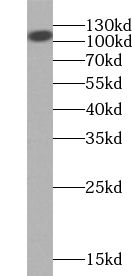Products
USP33 antibody
Category:
Research Area:
- SPECIFICATIONS
- Product Name
- USP33 antibody
- Catalogue No.
- FNab09325
- Size
- 100μg
- Form
- liquid
- Purification
- Immunogen affinity purified
- Purity
- ≥95% as determined by SDS-PAGE
- Clonality
- polyclonal
- Isotype
- IgG
- Storage
- PBS with 0.02% sodium azide and 50% glycerol pH 7.3, -20℃ for 12 months(Avoid repeated freeze / thaw cycles.)
Immunogen
- Immunogen
- ubiquitin specific peptidase 33
- Alternative Names
- Deubiquitinating enzyme 33 antibody, hVDU1 antibody, KIAA1097 antibody, Ubiquitin thiolesterase 33 antibody, USP33 antibody, VDU1 antibody
- UniProt ID
- Q8TEY7
- Observed MW
- 107 kDa
Application
- Tested Applications
- ELISA, WB, IHC
- Recommended dilution
- WB: 1:200-1:2000; IP: 1:200-1:1000; IHC: 1:20-1:200
Validated Images
 HEK-293 cells were subjected to SDS PAGE followed by western blot with FNab09325(USP33 antibody) at dilution of 1:300
HEK-293 cells were subjected to SDS PAGE followed by western blot with FNab09325(USP33 antibody) at dilution of 1:300
 Immunohistochemistry of paraffin-embedded human prostate cancer slide using FNab09325(USP33 Antibody) at dilution of 1:50
Immunohistochemistry of paraffin-embedded human prostate cancer slide using FNab09325(USP33 Antibody) at dilution of 1:50
- Background
- Deubiquitinating enzyme involved in various processes such as centrosome duplication, cellular migration and beta-2 adrenergic receptor/ADRB2 recycling. Involved in regulation of centrosome duplication by mediating deubiquitination of CCP110 in S and G2/M phase, leading to stabilize CCP110 during the period which centrioles duplicate and elongate. Involved in cell migration via its interaction with intracellular domain of ROBO1, leading to regulate the Slit signaling. Plays a role in commissural axon guidance cross the ventral midline of the neural tube in a Slit-dependent manner, possibly by mediating the deubiquitination of ROBO1. Acts as a regulator of G-protein coupled receptor(GPCR) signaling by mediating the deubiquitination of beta-arrestins(ARRB1 and ARRB2) and beta-2 adrenergic receptor(ADRB2). Plays a central role in ADRB2 recycling and resensitization after prolonged agonist stimulation by constitutively binding ADRB2, mediating deubiquitination of ADRB2 and inhibiting lysosomal trafficking of ADRB2. Upon dissociation, it is probably transferred to the translocated beta-arrestins, leading to beta-arrestins deubiquitination and disengagement from ADRB2. This suggests the existence of a dynamic exchange between the ADRB2 and beta-arrestins. Deubiquitinates DIO2, thereby regulating thyroid hormone regulation. Mediates deubiquitination of both 'Lys-48'-and 'Lys-63'-linked polyubiquitin chains.



